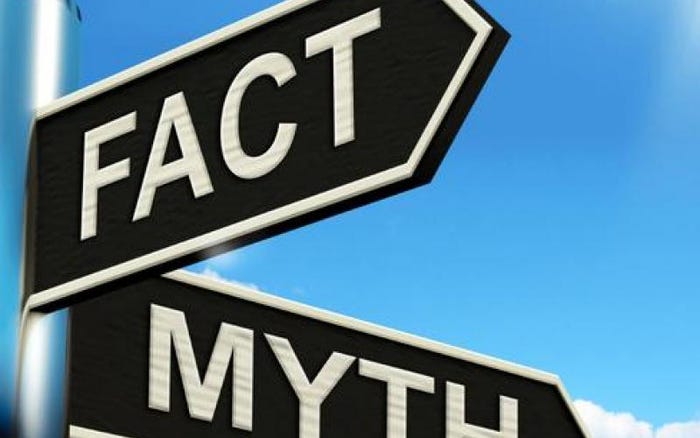6 SSD Myths Debunked
Solid-state drives are still gaining traction, despite misconceptions that have dogged the technology. We separate fact from fiction.
July 1, 2015

(Image: stuartmiles99)
Myth No. 1: SSDs wear out, don't have enough life for hard usage
Facts:
Flash has a limited number of writes before data may not be stored properly
This is well-characterized
Solutions are:
- Add spare space (over-provision) to the drive of 20+%
- Build-in RAID-like error correction
- Optimize use patterns; wear-leveling
- Throttle writing to prevent hotspotsResult: Effective wear life differs between drive models, mainly on over-provisioning levels
Drive is specified as having either eight years of life at "NNN" terabytes or "N" full drive writes per day
Most use cases fit the lowest levels of data per day
Only a few cases need the most durable drives
Drives are often sold with two or more durability levels (good, better, best).
Conclusion: BUSTED. Wear-out is no longer a concern.
(Image: Imgorthand)
Myth No. 2: When powered down, SSDs lose data quickly
Facts:
Heat DOES cause trapped electrons to tunnel faster, raising data-loss concerns
Theoretically, writing at low temperature and then storing at elevated temperature can cause data loss:
- Models indicate write at 60 degrees F and store at 120 degrees FThis isn't realistic, though:
- Typically, we write at 110 degrees F or higher, due to heat in servers
- We store at room temperature, or well below if we use salt minesThis makes the self-erase problem not an issue
Moreover, the archive model has shifted
- Users want faster access to their archived data (e.g. Facebook pics)
- We use archives that are always plugged inWe've not had complaints of retention loss.
Conclusion: BUSTED.
(Image: xiaoke ma)
Myth No. 3: Hard drives have many more years of firmware development, making them better
Facts:
This WAS true in the early days of SSDs
After nine years of development, today there is no gap
Still, SSD code continues evolving as hardware improves
Failure lifecycle is better understood
- Error correction is improving
- Effects of write patterns for small random writes are being addressedSo, the code is strong, but still evolving.
Conclusion: BUSTED.
(Image: Vermette)
Myth No. 4: Data reliability goes down with each die shrink
Facts:
Smaller features on die mean fewer electrons stored in each cell
Each die shrink "node" reduces write wear life and data reliability
This requires software and sophisticated signal processing to overcome
Fear that NAND was hitting a wall and could not shrink further
3D NAND resolves this:
- Uses an earlier processing node; bigger features
- Better wear-out
- Better retentionFuture capacity expansion is in 3D dimension; 64x and even 128x planned
Holds off the day when an alternative to NAND is needed
Conclusion: BUSTED -- but it was close!
(Image: donskarpo)
Myth No. 5: SAS isn't needed
Facts:
SAS interfaces offer a little better performance over SATA (most SSDs use SATA interfaces)
SSD specs less dependent on SAS or SATA interface protocol than HDD
PCIe -NVMe is taking over super-fast drive market
SATA and NVMe are combining into SATA-Express
- One interface solution for both top-end and bulk-tier drivesSAS is getting squeezed out
- Let's simplify life and "go with the flow"!
Conclusion: SAS ISN'T needed -- this really isn't a myth!
(Image: Danil Melekhin)
Myth No. 6: SSDs cost more than hard disk drives
Facts:
PCIe SSDs cost $2,000+ per terabyte; SATA SSDs from $300 and up
Enterprise SAS HDDs drives are $600+ and bulk SATA HDDs $35 per terabyte
2 PCIe SSDs outperform a $200,000 HDD array
SATA SSDs outperform enterprise HDD by a large factor and are half the price
Bulk HDDs still beat SSDs on price
3D NAND increases capacity per die by a big factor (64x layers in 2016, 8x capacity in 2017)
Fab processing increases by a much lower factor
Industry can back off two production "nodes"
- Older fabs can be used, increasing production and yield while saving investmentFlash vendors predict price parity with bulk hard drives in 2017
Conclusion: Myth partially busted already and fully busted in 2017.
(Image: miki1991)
SSDs: The Realities
SSD is now mainstream
Performance is stellar
- Random IOPS to 700,000 (versus 300 max for HDD)
- Sequential transfers to 3+GB per second (HDDs achieve 150 MB per second)SSD is low power, perhaps 1-2 watts compared with 12 W for HDD, though very high-end SSDs reach 10 W
No shock or vibration problems
Most SSDs use SATA interfaces
- SAS is being replaced by PCIe- NVMe
- SATA and NVMe are converging as a "SATA-Express" interface that can drive either protocolMost drives have specified maximum write rates that guarantee eight years of life
SSDs are cheaper than enterprise HDDs
SSDs will soon be larger and cheaper than bulk SATA HDDs
With smaller capacities than an HDD can achieve, SSDs are cheaper in the embedded market.
(Image: YuriyVlasenko)
SSDs: The Realities
SSD is now mainstream
Performance is stellar
- Random IOPS to 700,000 (versus 300 max for HDD)
- Sequential transfers to 3+GB per second (HDDs achieve 150 MB per second)SSD is low power, perhaps 1-2 watts compared with 12 W for HDD, though very high-end SSDs reach 10 W
No shock or vibration problems
Most SSDs use SATA interfaces
- SAS is being replaced by PCIe- NVMe
- SATA and NVMe are converging as a "SATA-Express" interface that can drive either protocolMost drives have specified maximum write rates that guarantee eight years of life
SSDs are cheaper than enterprise HDDs
SSDs will soon be larger and cheaper than bulk SATA HDDs
With smaller capacities than an HDD can achieve, SSDs are cheaper in the embedded market.
(Image: YuriyVlasenko)
(Image: stuartmiles99)
About the Author(s)
You May Also Like





